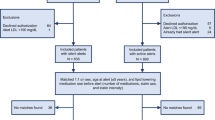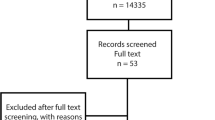Abstract
Introduction and objectives
The Optimcare study objective was to assess the impact on effectiveness and costs of a practice guideline implemented through a clinical decision support system (CDSS) for the management of patients with hypercholesterolemia in the primary healthcare setting.
Study design and perspective
The study design was a prospective, naturalistic, single-center (Vila Olímpica Primary Health Care Center, Barcelona, Spain), before-and-after design. Two periods were compared: (i) one year before (PRE) the implementation of the CDSS; and (ii) 1 year after (POS) the implementation of the CDSS. The recruitment period started in October 1999 (first patient, first visit) and ended 1 year later (last patient, last visit). The effectiveness was defined by the achievement of the treatment goals in PRE and POS periods. Costs of treatments, visits, and laboratory assessments were estimated from the social perspective (year of costing 2002).
Methods
The CDSS implemented algorithms agreed by the participating physicians based on national clinical guidelines, with therapeutic recommendations directed to achieve low-density lipoprotein (LDL) objectives in a cost-effective manner.
Patients
A total of 500 patients with hypercholesterolemia were randomly selected from the Primary Health Care center database.
Main outcome measures and results
After implementing the CDSS, the proportion of patients meeting the treatment goals increased by 11.9% (95% CI 5.9, 17.8), the median LDL values decreased by 10 mg/dL (95% CI −14, −6), the proportion of patients treated with drugs decreased by 14.6% (95% CI −19.4, −9.7), and the mean total costs per patient decreased by €78.4 (95% CI −94.7, −62.1). Therapeutic decisions agreed with the CDSS recommendations in 87.4% of the POS visits.
Discussion and conclusions
Despite some limitations in the design, the results of the present study strongly suggest that it is possible to optimize the efficiency of the management of hypercholesterolemia in standard practice by the implementation of a CDSS. After this implementation, not only were the effectiveness outcomes improved, but also a yearly mean reduction of €78.4 in the costs of management of patients with hypercholesterolemia was observed. This cost reduction, which was mainly due to a decrease in the number of patients treated with drugs, reverted to the spontaneous trend of a marked increase in the use of statins that was reported in Spain and other European countries during the study period.







Similar content being viewed by others
References
Law MR, Wald NJ, Thompson SG. By how much and how quickly does reduction in serum cholesterol concentration lower risk of ischaemic heart disease?. BMJ 1994; 308(6925): 367–72
Levine GN, Keaney JN, Vita JA. Cholesterol reduction in cardiovascular disease. N Engl J Med 1995; 332(8): 512–21
Gould AL, Rossouw JE, Santanello NC, et al. Cholesterol reduction yields clinical benefit: a new look at old data. Circulation 1995; 91(8): 2274–82
Expert Panel on Detection, Evaluation and Treatment of High Blood Cholesterol in Adults. Executive Summary of the Third Report of the National Cholesterol Education Program (NCEP) Expert Panel on Detection, Evaluation, and Treatment of High Blood Cholesterol in Adults (Adult Treatment Panel III). JAMA 2001; 285(19): 2486–97
Second Joint Task Force of European and Other Societies on Coronary Prevention. Prevention of coronary heart disease in clinical practice. Eur Heart J 1998; 19(10): 1434–503
Lago F, Abad Pérez JJ, Alvarez A, et al. Recomendaciones semFYC-Dislipemias. Barcelona: SemFYC, 1997
Abookire SA, Karson AS, Fiskio J, et al. Use and monitoring of “statin” lipidlowering drugs compared with guidelines. Arch Intern Med 2001; 161(1): 53–8
Backlund L, Danielsson B, Bring J, et al. Factors influencing GP’s decision on the treatment of hypercholesterolaemic patients. Scand J Prim Health Care 2000; 18(2): 87–93
Frolkis JP, Zyzanski SJ, Schwartz JM, et al. Physician noncompliance with the 1993 National Cholesterol Education Program (NCEP-ATPII) guidelines. Circulation 1998; 98(9): 851–5
Brotons C, Calvo F, Cascant P, et al. Is prophylactic treatment after myocardial infarction evidence-based?. Fam Pract 1998; 15(5): 457–61
Cobos A, Muñío S, Bigorra J. El consumo de estatinas en las comunidades autónomas de España: oportunidades para el ahorro. Aten Primaria 1999; 24(7189): 188–93
Walton R, Dovey S, Harvey E, et al. Computer support for determining drug dose: systematic review and meta-analysis. BMJ 1999; 318: 984–90
Hunt DL, Haynes RB, Hanna SE, et al. Effects of computer-based clinical decision support systems on physician performance and patient outcomes: a systematic review. JAMA 1998; 280(15): 1339–46
Delaney BC, Fitzmaurice DA, Riaz A, et al. Can computerised decision support systems deliver improved quality in primary care?. BMJ 1999; 319: 1281
Hingorani AD, Vallance P. A simple computer program for guiding management of cardiovascular risk factors and prescribing. BMJ 1999; 318(7176): 101–5
Hetlevik I, Holmen J, Kruger O, et al. Implementing clinical guidelines in the treatment of hypertension in clinical practice. Blood Press 1998; 7(5–6): 270–6
Montgomery AA, Fahey T, Peters TJ, et al. Evaluation of computer based clinical decision support system and risk chart for management of hypertension in primary care: randomised controlled trial. BMJ 2000; 320(7236): 686–90
Otto E, Semotok C, Andrysek J, et al. An intelligent diabetes software prototype: predicting blood glucose levels and recommending regimen changes. Diabetes Technol Ther 2000; 2(4): 569–76
Hopkins CB, Maysuria H. DATA: a decision aid for management of the patient with stable angina pectoris. Crit Rev Biomed Eng 2000; 28(1–2): 41–5
Tountas Y, Saroglou G, Frissiras S, et al. Remote access to an expert system for infectious diseases. J Telemed Telecare 2000; 6(6): 339–42
Soikos. Base de Datos de Costes Sanitarios SOIKOS
Vademecum Internacional de especialidades farmacéuticas y biológicas [online]. Available from URL: http://www.vademecum.medicom.es/paginas_htm/home.asp
Gambús G, Bassa A, Torremadé E, et al. V Reunión Científica de la Agencia Española de Evaluaciones de Tecnologías Sanitarias. Evaluación de Guías de Práctica Clínica. Valencia, 2002 Nov 6-8
Cobos A, Jovell AJ, García-Altés A, et al. Which statin is most efficient for the treatment of hypercholesterolemia?. A cost-effectiveness analysis. Clin Ther 1999; 21(11): 1924–36
Thompson SG, Barber JA. How should cost data in pragmatic randomised trials be analysed?. BMJ 2000; 320(7243): 1197–200
Altman DG, Machin D, Bryant TN, et al. Statistics with confidence. 2nd ed. Bristol: BMJ Books, 2000
Hahn GJ, Meeker WQ. Statistical intervals: a guide for practitioners. New York: John Wiley & Sons Inc, 1991
Walley T, Folino-Gallo P, Schwabe U, et al. Variations and increase in use of statins across Europe: data from administrative databases. BMJ 2004; 328(7436): 385–6
Fairhurst K, Huby G. From trial data to practical knowledge: qualitative study of how practitioners have assessed and used evidence about statin drugs in their management of hypercholesterolemia. BMJ 1998; 317(7166): 1130–4
Hobbs FD, Delaney BC, Carson A, et al. A prospective controlled trial of computerized decision support for lipid management in primary care. Fam Pract 1996; 13: 137–7
Lowensteyn I, Joseph L, Abrahamowicz M, et al. Can computerized risk profiles help patients improve their coronary risk? The results of the Coronary Health Assessment Study (CHAS). Prev Med 1998; 27(5 Pt 1): 730–7
López LA, Jiménez JM, Luna Jde D, et al. Opiniones de los gestores de la atención primaria sobre las fuentes de influencia en la práctica médica. Diferencias con la opinión de los médicos asistenciales. Gac Sanit 2002; 16: 417–24
Acknowledgments
Members of the Optimcare Study Group were: Luisa Bravo, BSN, Ana C Cereijo, MD, Elisabeth Font, BSN, Alba Gurt, MD, Teresa Martí, MD, Magda Miralles, MD, Francisco Montañés, MD, Oscar Peral, MD, Luisa Pérez, MD, Eva Rouco, BSN, Silvia Seres, BSN and Pilar Vilagrasa, BSN, Vila Olímpica Primary Health Care Center, Barcelona.
We also thank Juan Bigorra, MD, PhD for suggestions in the design phase and to Gemma Gambús, MD, PhD for the revision of the manuscript. It is equally appreciated the collaboration of the management of the Vila Olímpica Primary Health Care Center. This study has been carried out with the support of Novartis Farmacéutica, SA.
None of the authors have conflicts of interest other than those related to funding provided by Novartis Farmaceutica.
Author information
Authors and Affiliations
Corresponding author
Rights and permissions
About this article
Cite this article
Bassa, A., del Val, M., Cobos, A. et al. Impact of a Clinical Decision Support System on the Management of Patients with Hypercholesterolemia in the Primary Healthcare Setting. Dis-Manage-Health-Outcomes 13, 65–72 (2005). https://doi.org/10.2165/00115677-200513010-00007
Published:
Issue Date:
DOI: https://doi.org/10.2165/00115677-200513010-00007




